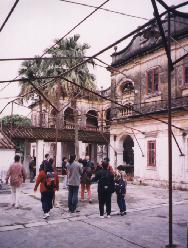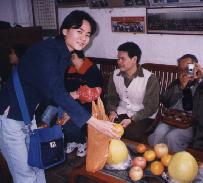Yesterday we visited St. Anthony Church in Shenzhen in Guangdong province in China, the province right across the fence from Hong Kong. We rented a bus to make sure we got there on time, gathering at 6:30 AM. Because it was so early and some of the group had to come from far parts of HK, many hadn't eaten breakfast. The railway station where we met has little cake shops so several deaf people went to buy something. When they came back, they offered me part of their bounty--loaves of plain white bread. That's perfectly in keeping with Chinese eating habits, though. While Americans wouldn't appreciate a handful of sliced white bread for breakfast, when HK people are on the road, that is normal fare.
After we had crossed the border, our driver realized he didn't know where the church was. One of our hearing volunteers used her mobile phone to call the parish priest in Shenzhen, and he sent the parish custodian peddling over on his bicycle to guide us back to the church. We piled his bike into the bus between the seats and were on our way.
 The church building is an old run-down, Mediterranean-style structure now jammed between various modern and much higher apartments and a school. The church wing itself was very small, with a tiny extension built off one side of the sanctuary. Homemade wooden seats with slats like park benches could hold probably one hundred people.The walls were plaster and there was a dropped ceiling above. Oneither side of the altar were two-foot high plaster statues--newly repainted--of a very western Mary and Sacred Heart in a cheap and most unappealing style (but probably the only thing available when there was money somewhere in the past to purchase them).
The church building is an old run-down, Mediterranean-style structure now jammed between various modern and much higher apartments and a school. The church wing itself was very small, with a tiny extension built off one side of the sanctuary. Homemade wooden seats with slats like park benches could hold probably one hundred people.The walls were plaster and there was a dropped ceiling above. Oneither side of the altar were two-foot high plaster statues--newly repainted--of a very western Mary and Sacred Heart in a cheap and most unappealing style (but probably the only thing available when there was money somewhere in the past to purchase them).
As our group entered the church some mainly middle-aged and older ladies were chanting with real gusto some prayers in a sing-songy pattern. (Talking with the old priest I live with who worked in the boonies of China before the Communist takeover, he said that they taught the people to memorize set morning prayers and they would chant them like that before each mass.)
The priest, a man in his late 30s, was from Beijing. I was a bit surprised to see someone so young. The whole liturgy was in Mandarin, the national language, even though the 50 million people of Guangdong speak Cantonese, the language of daily life there, probably a sign of the control the central government has over these "official" parishes of the Patriotic Church.
 The only sign of the Second Sunday of Advent was the purple vestments the priest wore. Interestingly, all the other ministers wore a white surplice over their street clothes--the two server boys, the two lectors, and a commentator. But the fact that they had other ministers was a big step forward from the last time I went to a mainland mass and it was facing the wall, the priest in fiddleback vestments, and all in Latin. That was about ten
years ago.
The only sign of the Second Sunday of Advent was the purple vestments the priest wore. Interestingly, all the other ministers wore a white surplice over their street clothes--the two server boys, the two lectors, and a commentator. But the fact that they had other ministers was a big step forward from the last time I went to a mainland mass and it was facing the wall, the priest in fiddleback vestments, and all in Latin. That was about ten
years ago.
A song (the Chinese version of Lucien Deiss' "My Shepherd Is the Lord") was sung while the collection was taken up immediately after the homily (there wasn't any creed), and then the priest and servers went to the front of the altar to receive the bread and wine. In a gesture that appealed to me in that small church, the priest, still in front of the altar, accepted the bread, immediately made a simple upward offering gesture with it, and gave it to the server who took it to the altar. The priest then did the same with the cup (with wine already in it). Then he paused at the side of the altar on his way back to the platform for a simple washing of his hands, and when he arrived back at the altar, the preparation of the gifts was fittingly completed and he went right into the prayer over the gifts and the preface. I liked the way his simple rite put the preparation of the gifts into proper persective in relation to more important parts of the liturgy.
Bells were rung at the consecration but most of the liturgy of the eucharist was similar to that in a Hong Kong parish. At communion time, there was an amazing influx of people throught the back door, and then I realized that maybe another 100-150 people were standing outside the church in a little courtyard. The hosts were very roughly made, very tiny wafers, about the size of a dime. Only about 15-20 people received communion in the hand. Strangely, the priest wrapped a purificator around the stem of the ciborium as he distributed communion.
Immediately after communion there was another sing-song chant. At
times it seemed like it was almost in harmony, or in parts, but
later I thought that maybe it was just the time difference between
the inside crowd and the outside crowd that caused that effect.
 We had no idea what was being prayed because all our sign language
interpreters are Cantonese speakers, and even those who have
studied Mandarin were not able to decipher the chants and even some
of the priest's prayers. More fervent chanting followed the final
blessing and dismissal.
We had no idea what was being prayed because all our sign language
interpreters are Cantonese speakers, and even those who have
studied Mandarin were not able to decipher the chants and even some
of the priest's prayers. More fervent chanting followed the final
blessing and dismissal.
Afterwards some of the congregation welcomed our deaf group into a small traditional Chinese hall and served us tangerines and slices of pomelo (a large grapefruit-like fruit) which they cut up on the spot. There I found that the priest spoke English very well, another sign of the new church in China.
Afterwards some of the parishioners joined us on the bus and drove us to the construction site of their huge new--and very expensive-looking--church rising out of a muddy field. The architecture is quite striking, very non-traditional. Like most Chinese churches, it will be seven or eight storeys tall, with offices and residences and meeting rooms on the floors above the church proper.
We didn't get off the bus there but only paused before heading for a Shenzhen hotel where we had a dinner before going to a set of amusement and theme parks set together on the outskirts of Shenzhen. The parks are very well layed out and very well constructed to a Disneyworld standard. They focus more on culture than amusement. One shows many of the world's landmarks in miniature. Another shows various cultural villages in China and other parts of Asia. A well-planned monorail connects the parks, hotels, and residential areas with a 20-minute loop. Most amazing about the monorail is its security feature: it uses a fingerprint scan to verify that passengers have paid as they get on and off the system at the ten or so various stops around the circuit!
The bus finally departed about 3:30 PM so we could avoid the usual huge crowds of travelers crossing the border between China and HK every weekend.